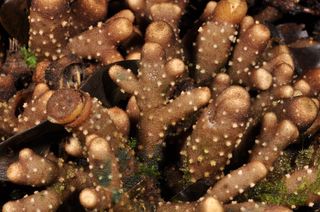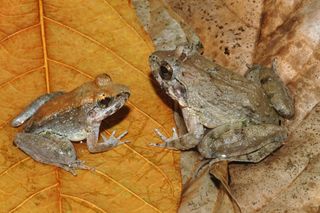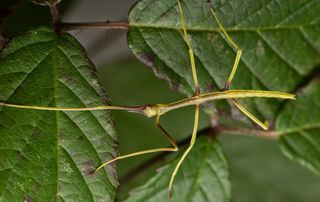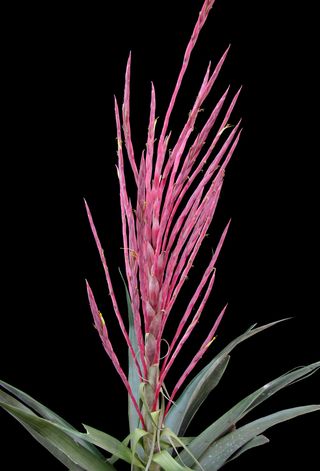Photos: Top 10 New Species
It's a big world out there. Scientists estimate that humans have discovered a mere 2 million of the 10 million or so species that roam the planet, and tragically, many of these species are vanishing before we have the chance to identify them.
Those species that we have discovered hint at the amazing and varied ways that life thrives on Earth. Each year, the SUNY College of Environmental Science and Forestry's International Institute for Species Exploration combs through the tens of thousands of newly named species and picks 10 that stand out. This year's list honors a long-extinct "chicken from hell" dino, an acrobatic spider and a humble animal that looks like a mushroom and doesn't quite fit in on the evolutionary tree of life, among others.
Read on for more about these bizarre new species.
1. Don't mess with this chicken

The "chicken from hell" is an eye-catching nickname, but the newly discovered dinosaur Anzu wyliei would not have contented itself with pecking around the front stoop for grubs. This North American dino grew to be 10 feet long (3.5 meters) and weighed up to 600 pounds (272 kilograms). It lived in what is now the Dakotas around the same time as Tyrannosaurus rex, and very likely sported a fine coat of feathers, researchers reported in March 2014 in the journal PLOS ONE.
Anzu wylieli probably hunted small animals and ate eggs, but took good care of its own young: Paleontologists find evidence that it made nests and brooded over its eggs until they hatched. (Illustration credit: Mark A. Klingler, Carnegie Museum of Natural History.)
2. A parasitic plant
Sign up for the Live Science daily newsletter now
Get the world’s most fascinating discoveries delivered straight to your inbox.

The bulbous, tuberous plant Balanophora coralliformis lives only in the Philippines — and only on one side of one mountain in the Philippines, as far as anyone knows. The plant is a parasite that can't conduct photosynthesis on its own, so it draws nutrients from the roots of other plants on the southwestern slopes of Mount Mingan between elevations of 4,800 feet and 5,600 feet (1,465 m and 1,735 m). Identifiable by its bumpy, above-ground tubers, B. coralliformis gets its scientific name from the fact that it looks more like an undersea coral than a landlubbing plant. Fewer than 50 plants have been found, making this species critically endangered. (Credit: P.B. Pelser & J.F. Barcelona.)
3. Acrobatic arachnid

Forget creeping and crawling. This spider does cartwheels.
Cebrennus rechenbergi, described in April 2014 in the journal Zootaxa, is a dun-colored arachnid that lives in Moroccan sand dunes. The spider hides from predators in its own sandcastles, towers made of silk and sand that also provide respite from the desert sun. When threatened, though, C. rechenbergi does something really wild: It breaks into a run that soon turns into a tumble, cartwheeling at 6.5 feet per second (2 meters per second) up and down the dunes. (Credit: Prof. Dr. Ingo Rechenberg, Technical University Berlin.) [See Photos of the Agile Arachnid]
4. Animal or mushroom?

Dendrogramma enigmatica is truly the mystery that its name suggests. These teeny animals look like miniature mushrooms, with stalks only a third of an inch (8 millimeters) long and caps half an inch (11 mm) wide. In fact, their "stalks" end in a combination mouth/anus and their caps contain a network of digestive tubes. Researchers found these bizarre creatures in mud collected off the coast of Australia, but have no idea how they live in their native environment. Nor can they easily shunt the species into an existing branch on the tree of life. They're probably related to true jellyfish or comb jellies, taxonomist Jean Just told Live Science in September 2014, but they don't fit nicely into either group. (Credit: Jørgen Olesen.)
5. A doting wasp mom

It's sort of sweet, in a morbid way: The new wasp Deuteragenia ossarium carefully hunts down a spider, places it in a hollow plant stem and then lays an egg nearby before sealing this little nursery chamber shut with dirt. She'll repeat the process several times before creating a final, gruesome antechamber, this one filled with the dead bodies of a dozen or so ants. When the wasp's eggs hatch, her offspring have spider snacks readily available, and are camouflaged or protected by the scent of the ant mausoleum.
The discovery of the wasps, which live in eastern China, was announced in July 2014 in the journal PLOS ONE. (Credit: Michael Staab.)
6. A fanged frog

The fanged frog Limnonectes larvaepartus forgoes eggs, instead giving birth to live tadpoles. It's a very strange arrangement for the amphibian, as most frogs lay eggs. It was also a very strange discovery for herpetologist Jim McGuire of the University of California, Berkeley, who was on the Indonesian island of Sulawesi when he grabbed what he thought was a male frog.
"As soon as I picked her up, she squirted tadpoles all over my hand," McGuire told Live Science in December 2014.
L. larvaepartus is now the only known frog species to give birth to live tadpoles (a few species give birth to mini "froglets"). The frogs also sport fanglike protuberances on their lower jaws, which they use when fighting. (Credit: Jimmy A. McGuire.)
7. A graceful insect

Long-limbed and long-bodied, Phryganistria tadaoensis is part of an insect family known as giant sticks. It looks, well, like a giant stick. Found in Vietnam, this new stick insect grows to be 9 inches (23 cm) long.
Stick insects are gentle giants; they perch quietly in trees, blending in with the background and eating leaves, according to the Australian Museum. Phryganistria tadaoensis was discovered in the town of Tam Dao, Vietnam, where it is common but overlooked, according to SUNY ESF. (Credit: Dr. Bruno Kneubühler.)
8. Electric beauty

The gorgeous, glowing sea slug Phyllodesmium acanthorhinum looks like the gastopod version of a neon sign. Described in the journal The Veliger, this slug was discovered off the coast of Japan and grows to only about an inch (17 mm to 28 mm) in length.
Species of the Phyllodesmium genus live symbiotically with algae in their guts, which provide nutrients the sea slugs don't get from their diets alone. (Credit: Robert Bolland.)
9. A Christmas decoration becomes a discovery

Sometimes, new species are hiding in plain sight. Such was the case of Tillandsia religiosa, a spiky green-and-red bromeliad plant found in Mexico. The villagers of Sierra de Tepoztlán, Tlayacapan, San José de los Laureles, and Tepoztlán had long used this plant to decorate alters during the Christmas season. It wasn't until researchers from Universidad Autónoma del Estado de Morelos and Universidad Autónoma Metropolitana-lztapalapa began projects classifying plant species in Morelos, Mexico, that anyone realized that these plants had never been identified scientifically. The researchers presented their findings in the journal Phytotaxa. (Credit: A. Espejo.)
10. A fish dedicated to home improvement

Diving off the coast of Japan's Amami-Oshima Islands, you might discover beautiful circular patterns of sand along the ocean floor, stretching out 7 feet (2 m) in diameter. Ancient aliens might come to mind, but the real culprit is a 5-inch (12 cm) long fish.
The discovery of Torquigener albomaculosus, a new species of pufferfish, solved a decades-long mystery about the enigmatic seafloor circles first noted in 1995. Males of the species wiggle and gyrate in the sand to create the patterns, which females then critique with a discerning eye. If a female likes what she sees, she mates with the male and lays her eggs in the center of the circle. The sandy ridges help protect the eggs from ocean currents, researchers explained in July 2013 in the journal Scientific Reports. The new species responsible was described in the journal Ichthyological Research in January 2015. (Credit: Yoji Okata.)
Follow Stephanie Pappas on Twitter and Google+. Follow us @livescience, Facebook & Google+.

Stephanie Pappas is a contributing writer for Live Science, covering topics ranging from geoscience to archaeology to the human brain and behavior. She was previously a senior writer for Live Science but is now a freelancer based in Denver, Colorado, and regularly contributes to Scientific American and The Monitor, the monthly magazine of the American Psychological Association. Stephanie received a bachelor's degree in psychology from the University of South Carolina and a graduate certificate in science communication from the University of California, Santa Cruz.
Most Popular

